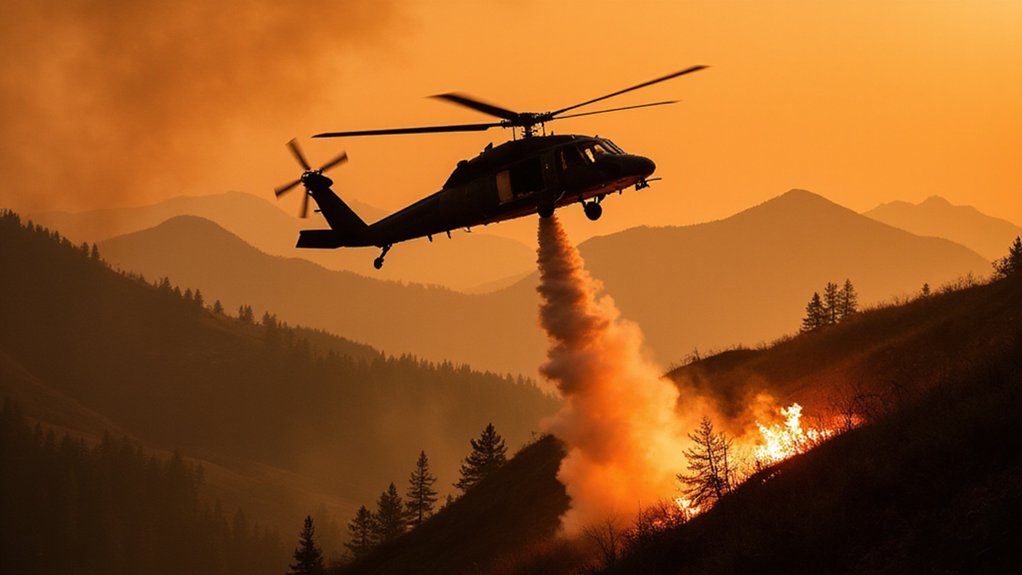California’s latest weapon against wildfires isn’t a firefighter—it’s a robot. An autonomous Black Hawk helicopter recently tested in Southern California can spot fires using advanced sensors while streaming video to ground teams. The unmanned aircraft flies into dangerous conditions without risking human lives. “This technology will change everything,” says Fire Chief Martinez. State officials have already pledged funding for more units. But will these flying robots truly transform California’s wildfire response?
Dozens of firefighters watched in awe as an unmanned Black Hawk helicopter swooped down to battle flames during recent tests in Southern California. Sikorsky and Rain completed these groundbreaking flight tests in late April 2025, demonstrating new autonomous firefighting technology that could transform how California fights wildfires.
The optionally piloted Black Hawk completed 24 hours of flight time over a two-week period. It used advanced sensors to locate fires and stream video to ground operators’ tablets. Throughout the tests, Sikorsky safety pilots remained on board but kept their hands off the controls as the helicopter operated autonomously.
During tests, safety pilots watched as the autonomous Black Hawk flew itself, tracked fires, and transmitted live video data to ground teams.
San Bernardino County firefighters built and ignited multiple brush piles for the tests. A 189,000-gallon water tank positioned less than a mile from the burn sites provided water for the helicopter’s drops. Representatives from Cal Fire, San Bernardino County Fire District, Orange County Fire Authority, and the US Forest Service observed the demonstration.
The autonomous Black Hawk is similar to the Firehawk helicopters already used by Cal Fire and local departments. These helicopters feature 1,000-gallon belly-mounted water tanks. California agencies currently operate 24 Sikorsky S-70 Firehawk helicopters, with three more scheduled for delivery to Cal Fire this year.
California Assembly Bill 270 aims to establish a pilot project within CAL FIRE to evaluate these autonomous capabilities. The bill would require operators to submit specific information as part of the project.
During testing, the autonomous system demonstrated it could communicate with crewed firefighting aircraft in the same area, including an Orange County Fire Authority Sikorsky S-76 command helicopter. The operations were conducted at 3,300 feet altitude with wind gusts reaching up to 30 knots.
This technology could improve safety by reducing human risk exposure and enhance efficiency in firefighting response times. The helicopter’s thermal sensing capabilities enable it to detect fire hotspots that might be invisible to the human eye. It might also extend operations during periods when human pilots face visibility challenges or fatigue limitations.
Current firefighting helicopters require full crews, which limits deployment during peak fire seasons. With autonomous technology, California’s firefighting capabilities could operate more continuously, potentially saving more homes and lives from destructive wildfires.
References
- https://news.lockheedmartin.com/2025-05-01-Rain-and-Sikorsky-Test-Advanced-Aerial-Firefighting-Technologies-Using-Autonomous-Black-Hawk-Helicopter
- https://trackbill.com/bill/california-assembly-bill-270-department-of-forestry-and-fire-protection-autonomous-firefighting-pilot-project/2622128/
- https://apcp.assembly.ca.gov/media/926
- https://abc7.com/post/autonomous-firefighting-firehawk-helicopter-designed-put-fires-may-solution-increased-efficiency-safety/16297253/
- https://www.aerospacetestinginternational.com/news/autonomous-black-hawk-helicopter-tested-for-firefighting.html








